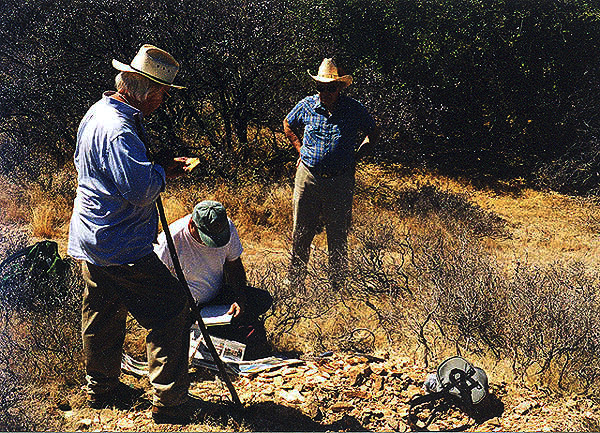
|
Paleobotanist Howard Schorn (standing) examines a fossil plant specimen at the famous "Lygodium Gulch" locality in the Middle Eocene Ione Formation, while paleobotanist Dr. Jack A. Wolfe (kneeling) refers to his field notes; my late father (blue plaid shirt and cowboy hat, an Engineering Geologist) observes the proceedings. Dr. Wolfe was well-pleased with the abundance and quality of the fossil plants from Lygodium Gulch. If the National Science Foundation Grant came through, a proposal to study the rich Eocene floras of the western foothills of the Sierra Nevada, this specific site would be a prime locality to quarry in order to secure a wider selection of specimens to analyze. Image was taken on August 19, 2000. After securing numerous quality fossil plant specimens from "Lygodium Gulch," Dr. Wolfe and Tony needed to take a detour back to town. While they were gone for awhile, Dr. Tiffney expressed interest in trying to locate sites in the Ione Basin that might produce fossil seeds and/or fruits--his primary interest and professional paleobotanical specialty. I told him that I recollected one site that had seemed promising--a place where highly carbonaceous mudstones were exposed in an easily accessible gully several miles from "Lygodium Gulch." But, before Dr. Wolfe and Tony took off for town, we all agreed to meet back at the Ione Shopping Center in Ione for lunch. At the possible seed and fruit site, Dr. Tiffney brought out the heavy-duty pick he had utilized at Lygodium Gulch and proceeded to expose Ione Formation strata below the surface. With a high-quality hand-lens he then carefully and expertly examined each chunk of carbonaceous mudstone for fossil seeds and fruits. Unfortunately, none came to light. At his car before leaving, Dr. Tiffney produced a map he had used several years earlier during a visit to the Ione Basin in search of fossil seeds and fruits. On that map he had pinpointed all of the sites he had explored--although none had produced seeds or fruits (or leaves, for that matter). After examining the map for a few moments, he remarked with great surprise that the site I had taken him to was one of the very same localities he had explored all of those many years before. Please note: All fossil localities in the Ione Formation of Amador County, California, presently occur on private property; explicit permission from the land owners must be secured before collecting fossils there. |